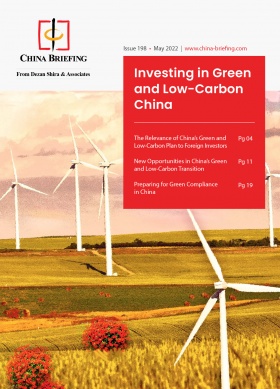Sustainable Fashion in China: An Emerging Trend in the Apparel Industry
The sustainable fashion movement is taking the fashion and apparel industry by storm, as people around the world are increasingly conscious of the environmental impacts of their consumption habits. The sustainable fashion trend is also beginning to take root in China, driven by young, urban, and increasingly environmentally conscious consumers.
With the rise of fast fashion – the mass production of cheap and readily disposable clothing – the fashion and apparel industry has come under increasing scrutiny from environmental activists. By some measures, the fashion and apparel industry is responsible for 4-10 percent of global greenhouse gas emissions.
In contrast to fast fashion, sustainable fashion emphasizes low-emissions clothing products that are built to last. As China seeks to radically reduce its greenhouse gas emissions, sustainable fashion has the potential to transform the country’s fashion and apparel industry – but requires long-term investments to drive cultural change among consumers.
What is sustainable fashion?
Sustainable fashion, also known as green fashion, refers to fashion and apparel brands whose business models emphasize the importance of environmental and social sustainability. Sustainable fashion brands may, for example, feature apparel that is less polluting to produce, use locally sourced materials, or use recycled materials.
Many synthetic fibers commonly used in mass produced apparel are technically forms of highly polluting plastic, such as polyester, nylon, and acrylic. Such fibers are not only polluting to produce but contribute to microplastics pollution in the ocean during their lifecycles.
Additionally, sustainable fashion brands may also be leaders on environmental, social, and governance (ESG) indicators. For example, such brands may adhere to high sustainability and labor standards throughout their supply chains.
In practice, sustainable fashion brands engage in a wide range of practices to cut their carbon footprints. The US brand Everlane, for instance, produces jeans using just 0.4 liters of recycled water, compared to the 1,500 liters of water used for most jeans. The Chinese brand Klee Klee, meanwhile, offers free repair and recycling services as part of its efforts to reduce waste and pollution.
Some fashion and apparel brands may not fall under the category of sustainable fashion, but still adopt practices to improve their sustainability, particularly as ESG indicators become increasingly important among consumers, investors, and regulators. For example, many fashion and apparel brands acquire voluntary environmental certifications, adhere to Global Reporting Initiative standards, and commit to other ESG-related standards.
A niche but emerging trend in China
China is an enormous market for fashion and apparel. According to government figures, enterprises above a designated scale (report annual revenue of over RMB 20 million from main business) produced 23.54 billion garments in 2021, an 8.4 percent increase over the previous year, and reached RMB 997.46 billion (US$138.87 billion) in sales, a 14.2 percent increase. The market research firm Askci Research projected China’s overall garment market to grow to RMB 1.45 trillion (US$201.87 billion) in 2022.
There is a pressing need for greater sustainability in China’s fashion and apparel industry. Currently, the vast majority of apparel in China is not recycled after use, whether through the secondhand market or re-use of materials. About 26 million tons of clothes in China are thrown away per year, and less than one percent of them are reused or recycled.
The Chinese government is taking steps to reduce waste and pollution in the country, while promoting green business practices across industries. Most notably, the Chinese government pledged to hit peak carbon emissions before 2030 and become carbon neutral before 2060. Given this pledge, greater sustainability in the fashion and apparel industry may soon become the norm rather than an exception.
While the sustainable fashion industry makes up only a small portion of the fashion and apparel industry overall, numerous indicators suggest there is growing market potential. According to a survey conducted by the market research firm Daxue Consulting, 77 percent of surveyed Chinese consumers are willing to pay a premium of 5-20 percent for sustainable fashion products, indicating growing awareness of the importance of sustainability.
Indeed, China’s most prominent sustainable fashion brands, such as Icicle, Klee Klee, Krop, and Ziran, largely cater to a higher-end market. Other companies, like Bastine, focus on sustainable textile production. Some foreign brands specializing in sustainable fashion have entered the Chinese market, such as Everlane and Allbirds, to mixed success.
Although sustainable fashion is currently a high-end market in China, there is potential for it to go mainstream, as Chinese consumers display some underlying behaviors that support sustainable fashion.
According to a survey by PwC, 74 percent of Chinese consumers tend to choose brands with traceable sources and a transparent origin, compared to 56 percent globally. Interest in transparency among Chinese consumers stems in part from experience with fake and sometimes hazardous products, which were once commonplace in the Chinese market.
Young people leading growth
In China, the idea that someone would pay a premium for clothes made from recycled materials is not mainstream. During China’s economic boom over the last several decades, consumers stressed the value of newness, rather than recycled or vintage. Many people also hold a stigma that secondhand clothing is unhygienic.
While not all sustainable fashion products are made from recycled materials, such an attitude reflects a product perception barrier that sustainable fashion brands in China must overcome.
However, young Chinese consumers appear to be more interested in sustainable fashion than previous generations. A report by the firm Research And Markets finds that sustainable fashion is still a new concept for Chinese consumers, but that awareness is rapidly growing among young, urban consumers.
Likewise, according to the Daxue Consulting survey, young Chinese people with higher incomes and advanced education are the most likely to adapt their purchasing behavior because of sustainability concerns. Up to 20 percent of upper-class respondents said that they were willing to pay double for sustainable fashion products.
In addition to newly made sustainable apparel, buying secondhand clothing has become increasingly commonplace. Chinese e-commerce platforms used for secondhand shopping include Catch Fish, Fat Tiger, Feiyu, Zhier, Zhuanzhuan, Xianyu, and Value Yao.
According to research from iiMedia Consulting, over 60 percent of consumers on Chinese secondhand trading platforms were born in the 1990s. However, while some secondhand consumption reflects consumer interest in sustainable fashion, for others it is simply interest in vintage clothes or a cost-effective shopping option.
Driving change through social channels
Popularizing the concept of sustainable fashion requires long-term investments to educate consumers about the benefits of such products and relate them to their lifestyles.
To do so, sustainable fashion brands can leverage online social channels to drive change and move beyond the luxury market into the mainstream in China. Such channels are important for both the logistics of completing sales as well as for communicating the importance of sustainable lifestyles more broadly.
The market research firm Research And Markets projects online channels to make up 38.6 percent of China’s apparel market in 2025. Creating a successful online presence in China, however, requires a social media strategy and comprehensive online strategy rather than just an e-commerce storefront.
This can be seen most visibly in the key role that influencers play in China’s fashion and apparel industry, especially through livestreams connected with e-commerce platforms. In 2020, China’s livestreaming e-commerce market grew by 121.5 percent to reach RMB 961 billion (US$133.79 billion), showing the channel’s explosive growth. This figure is projected to reach RMB 1.2 trillion (US$180 billion) in 2022, according to a 2021 iResearch report.
The social media and e-commerce platform Xiaohongshu is one of the most popular apps for fashion influencers and product sales, especially for young women. According to Vogue Business, the number of “sustainable”-related notes on the fashion and cosmetics app Xiaohongshu is close to 300,000.
Engaging influencers promoting socially and environmentally conscious lifestyles may be an effective way for sustainable fashion brands to promote awareness of the need – and trendiness – of sustainable fashion. Nevertheless, while sustainable fashion brands have avenues to find success in the Chinese market, popularizing the concept requires a long-term strategy as consumers gradually adjust their lifestyle priorities.
About Us
China Briefing is written and produced by Dezan Shira & Associates. The practice assists foreign investors into China and has done so since 1992 through offices in Beijing, Tianjin, Dalian, Qingdao, Shanghai, Hangzhou, Ningbo, Suzhou, Guangzhou, Dongguan, Zhongshan, Shenzhen, and Hong Kong. Please contact the firm for assistance in China at china@dezshira.com.
Dezan Shira & Associates has offices in Vietnam, Indonesia, Singapore, United States, Germany, Italy, India, and Russia, in addition to our trade research facilities along the Belt & Road Initiative. We also have partner firms assisting foreign investors in The Philippines, Malaysia, Thailand, Bangladesh.
- Previous Article Investing in Nanjing: Industry, Economics, and Policy
- Next Article New Inspection Regime for Hong Kong Companies: Phase 2 from October 24, 2022








